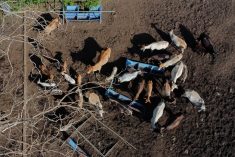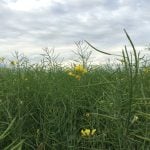Two research papers, one in Canada and the other at Kansas State University, have concluded Jumpstart does not increase yields or phosphorus uptake in wheat and corn.
The Novozymes-manufactured inoculant uses a fungus called penicillium balaii.
The company says on its website that Jumpstart makes the fixed mineral forms of phosphorus in the soil available to crops, which in turn improves phosphorus use efficiency and reduces the need for phosphate fertilizer.
However, authors of the Canadian paper, including Viterra agronomy manager Rigas Karamanos, determined that Jumpstart didn’t improve agronomic efficiency by allowing producers to cut phosphorus inputs and achieve the same yield results.
Read Also

John Deere balers get weave automation
John Deere’s 1 Series round balers for 2026 will include an automated weaving hitch that oscillates the unit over a windrow to better form a “square-shouldered” round bale.
“Use of the phosphorus solubilizing fungus penicillium bilaii, in conjunction with seed-placed P fertilizer at three different rates, resulted in no benefit either in the yield or removal of P by hard red spring wheat,” Karamanos wrote in the conclusion of the paper, which was published in the Canadian Journal of Plant Science this spring.
Karamanos said the paper’s findings speak for themselves and wouldn’t comment further.
He co-authored the paper with Norm Flore, manager of agronomic services with Viterra, and John Harapiak, a retired agronomist who previously worked for Western Co-operative Fertilizer, which is now Viterra.
The authors based their conclusions on Western Co-operative Fertilizer’s field data at 26 prairie locations from 1989 to 1995.
Researchers carried out 47 experiments in which they applied zero, 3.9, 7.7 and 11.7 pounds of phosphorus per acre.
Only 14 plots of spring wheat responded to the penicillium balaii inoculant: nine saw a reduction in yield and phosphorus uptake and five showed an increase in uptake and yield.
“These responses could not be attributed either to extractable P soil concentration, soil organic matter or texture, or weather conditions, and are considered random events. Overall, P uptake was a function of fertilizer P rate only,” the authors said.
The Kansas State paper is based on more recent experiments on corn and winter wheat and were conducted across Kansas in 2008 and 2009.
Nicholas Ward, a master’s student in agronomy at the university, studied the efficacy of Jumpstart and Avail, a polymer-coated product that claims to reduce the amount of phosphorus lost to the soil.
“By blocking the bonds of attraction of chemical elements in the soil to the phosphorus, more of the phosphorus is available for your crop to utilize,” said SFP, which manufactures Avail.
Ward found that applying more phosphorus boosted nutrient uptake for winter wheat but not consistently for corn.
He also found that Jumpstart and Avail didn’t improve yields or uptake, even when the wheat responded to phosphorus applications.
“With the wheat trials, we had no response to either product while the locations responded to phosphorus fertilizer,” Ward said in a presentation to the American Society of Agronomy meeting held in Pittsburgh last fall.
Ward completed his master’s program this year, but his thesis hasn’t been published in a peer-reviewed journal. He is now working on his PhD in agronomy at the University of Nebraska.
David Mengel, an agronomy professor at Kansas State and Ward’s supervisor, said they initiated the study because there was a lack of research on Jumpstart in the United States and Novozymes was selling the product in the region.
“They were marketing it pretty intensively, so our growers had questions,” said Mengel, who wasn’t surprised by the study’s results.
“If you look at a lot of the (Canadian) research data, there’s not a lot of consistent responses that have been reported in the literature.”
Based on the Kansas data, Jumpstart marginally improved phosphorus uptake and yield when no phosphorus was applied, Mengel said.
“But those responses were relatively small and they weren’t statistically significant,” he added.
“They weren’t nearly as large as you got with fertilizer.”















